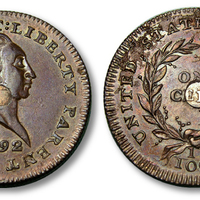https://financialservices.house.gov/news/documentsingle.aspx?DocumentID=237384
In this link from 2011, Paul shows his interest in coin as Bureau of Weights and Measures topic, if, as appropriate to a topic at core involving money, in one view of it, an activity conducted by the Mint, the Treasury.
The government certifying a specific quantity (nine tenths of an ounce of silver, in the original dollar coin of 1792, or of gold, in the twenty dollar coin) when money is thought to be and is thought to ought to be bullion adds but little service to either the public or to itself in its basic, fiscal, functions. It is interesting to note, though, that there was a period in the nineteenth century in which the Treasury provided for the free minting of private silver into dollar coins. Not entirely free--similar to our primary dealer system with Treasuries, I think this service was limited to the mining companies. But what that provided--given the somewhat unlimited supply of silver due to its production as byproduct of the mining of other metals--is a solid money supply, at least in terms of daily currency. A book I am reading points out one has to differentiate the MQ of coins and paper dollars from the total MQ, the bulk of which historically was always first and foremost ledger money. But if talking coins, one must still point out that with a growing economy, a growing supply of daily use wallet currency is nevertheless still required; if the coins themselves rise in value, as they will, even against the material they are made of, whether gold or silver, due to lack of minting, the coins will fail to circulate as they will serve instead as collateral in bank vaults the way bullion has always done; and also one must point out that even now, coin and paper dollars are a significant portion of our money.
In this situation, in the link: The Treasury is minting bullion coins, and then selling them roughly at par to the public. It is an unnatural activity that would serve very little purpose were said coins actually intended as real currency--barring if the supply were in no wise withheld, money supply as described above. In that real currency scenario, the government would, ideally, directly spend these coins fiscally into circulation or, as now with our quarters, nickels, dimes and pennies, sell them to the banks for use in the Moneymatic Machine supply cycle, not to collectors item dealerships. The coins would have a concrete use and purpose and actually enter circulation by such sort of means.
The price of a silver dollar would, by actual use, together with the growing money supply demand of a growing world silver dollar economy, rise above that of the silver they are minted with except as held in check by sufficient mintage thereof. Due to the artificial demand provided by taxes to the value of money, a government minted silver dollar should also by that means naturally rise bit by bit continually above the market value of the silver it contains, if no countermeasures were deployed to prevent it; as the same principle equally applies to the ratio of the value of a greenback to its, albeit tremendously lower price of paper raw material, it seems clear that something has gone quite wrong such that the value of an ounce of silver is now twenty dollars rather than the value of a dollar, once equal to .9 ounces of silver, is not instead now worth twenty ounces in silver. As this principle of taxation inserting the "tiny silver plug core" of value into the otherwise too physically large penny should apply to a large or small quantity of money supply in a non one-to-one ratio--since we are applying value, not quantity into the core of the coin, together with the other points of growth of the economy et cetera, it is not "money printing" per se that has devalued the dollar twenty times from its 1792 value (granting the false premise for purpose of discussion that bullion represents accurately the value of goods and services). Perhaps taxes are too low to properly drive demand for the currency. I add that fiscal spending, as, like that of any business or organization, is intended to a purpose and purpose equates to supply--that low fiscal spending equates to high prices. A failure to tax profits and reapportion them into useful production is also a source, again, of high prices due to a failure of adequate material supply that comes from gradual monopolization, and thereby, gradual withdrawal from use, of resources by the private sector entities that acquire them.
People
Circles
Posts
EV COLLAPSE: Car dealerships are now rejecting EV deliveries due to low sales
https://newstarget.com/2023-09-06-car-dealerships-rejecting-ev-deliveries-low-sales.html

Car dealerships are now rejecting further deliveries of electric vehicles (EVs) due to low sales. But despite this, EV manufacturers are continuing to scale up their production. According to Scott Kunes, the COO of Kunes Auto and RV Group, they have turned away additional EV inventory to ensure a healthy turnover rate. Other dealers are sharing the […]
www.newstarget.com
EV COLLAPSE: Car dealerships are now rejecting EV deliveries due to low sales
https://www.naturalnews.com/2023-09-06-car-dealerships-rejecting-ev-deliveries-low-sales.html

Car dealerships are now rejecting further deliveries of electric vehicles (EVs) due to low sales. But despite this, EV manufacturers are continuing to scale up their production. According to Scott Kunes, the COO of Kunes Auto and RV Group, they have turned away additional EV inventory to ensure a healthy turnover rate. Other dealers are sharing the […]
www.naturalnews.com
Videos
People
Circles
Videos
Posts
https://financialservices.house.gov/news/documentsingle.aspx?DocumentID=237384
In this link from 2011, Paul shows his interest in coin as Bureau of Weights and Measures topic, if, as appropriate to a topic at core involving money, in one view of it, an activity conducted by the Mint, the Treasury.
The government certifying a specific quantity (nine tenths of an ounce of silver, in the original dollar coin of 1792, or of gold, in the twenty dollar coin) when money is thought to be and is thought to ought to be bullion adds but little service to either the public or to itself in its basic, fiscal, functions. It is interesting to note, though, that there was a period in the nineteenth century in which the Treasury provided for the free minting of private silver into dollar coins. Not entirely free--similar to our primary dealer system with Treasuries, I think this service was limited to the mining companies. But what that provided--given the somewhat unlimited supply of silver due to its production as byproduct of the mining of other metals--is a solid money supply, at least in terms of daily currency. A book I am reading points out one has to differentiate the MQ of coins and paper dollars from the total MQ, the bulk of which historically was always first and foremost ledger money. But if talking coins, one must still point out that with a growing economy, a growing supply of daily use wallet currency is nevertheless still required; if the coins themselves rise in value, as they will, even against the material they are made of, whether gold or silver, due to lack of minting, the coins will fail to circulate as they will serve instead as collateral in bank vaults the way bullion has always done; and also one must point out that even now, coin and paper dollars are a significant portion of our money.
In this situation, in the link: The Treasury is minting bullion coins, and then selling them roughly at par to the public. It is an unnatural activity that would serve very little purpose were said coins actually intended as real currency--barring if the supply were in no wise withheld, money supply as described above. In that real currency scenario, the government would, ideally, directly spend these coins fiscally into circulation or, as now with our quarters, nickels, dimes and pennies, sell them to the banks for use in the Moneymatic Machine supply cycle, not to collectors item dealerships. The coins would have a concrete use and purpose and actually enter circulation by such sort of means.
The price of a silver dollar would, by actual use, together with the growing money supply demand of a growing world silver dollar economy, rise above that of the silver they are minted with except as held in check by sufficient mintage thereof. Due to the artificial demand provided by taxes to the value of money, a government minted silver dollar should also by that means naturally rise bit by bit continually above the market value of the silver it contains, if no countermeasures were deployed to prevent it; as the same principle equally applies to the ratio of the value of a greenback to its, albeit tremendously lower price of paper raw material, it seems clear that something has gone quite wrong such that the value of an ounce of silver is now twenty dollars rather than the value of a dollar, once equal to .9 ounces of silver, is not instead now worth twenty ounces in silver. As this principle of taxation inserting the "tiny silver plug core" of value into the otherwise too physically large penny should apply to a large or small quantity of money supply in a non one-to-one ratio--since we are applying value, not quantity into the core of the coin, together with the other points of growth of the economy et cetera, it is not "money printing" per se that has devalued the dollar twenty times from its 1792 value (granting the false premise for purpose of discussion that bullion represents accurately the value of goods and services). Perhaps taxes are too low to properly drive demand for the currency. I add that fiscal spending, as, like that of any business or organization, is intended to a purpose and purpose equates to supply--that low fiscal spending equates to high prices. A failure to tax profits and reapportion them into useful production is also a source, again, of high prices due to a failure of adequate material supply that comes from gradual monopolization, and thereby, gradual withdrawal from use, of resources by the private sector entities that acquire them.
EV COLLAPSE: Car dealerships are now rejecting EV deliveries due to low sales
https://newstarget.com/2023-09-06-car-dealerships-rejecting-ev-deliveries-low-sales.html

Car dealerships are now rejecting further deliveries of electric vehicles (EVs) due to low sales. But despite this, EV manufacturers are continuing to scale up their production. According to Scott Kunes, the COO of Kunes Auto and RV Group, they have turned away additional EV inventory to ensure a healthy turnover rate. Other dealers are sharing the […]
www.newstarget.com
EV COLLAPSE: Car dealerships are now rejecting EV deliveries due to low sales
https://www.naturalnews.com/2023-09-06-car-dealerships-rejecting-ev-deliveries-low-sales.html

Car dealerships are now rejecting further deliveries of electric vehicles (EVs) due to low sales. But despite this, EV manufacturers are continuing to scale up their production. According to Scott Kunes, the COO of Kunes Auto and RV Group, they have turned away additional EV inventory to ensure a healthy turnover rate. Other dealers are sharing the […]
www.naturalnews.com
CarEdge - The Ugly Truth at FORD | Customers OUTRAGED:
https://www.youtube.com/watch?v=acGws6uGoMA
#Ford #FMC #EVs #Dealerships #Recalls #QualityAssurance #FalseNarrative #CarPrices #Incentives #InterestRates #CarLoans #Affordability #Economics
I can't help but think the boycott on Ford has anything to do with them going all in on the Transgender Woke Rainbow Train like BudLight Beer.
Why EVs Are ‘Piling Up’ at Dealerships, Despite Massive Taxpayer Subsidies https://fee.org/articles/why-evs-are-piling-up-at-dealerships-despite-massive-taxpayer-subsidies/
“About 92,000 EVs currently sit on dealers’ lots; that's a 342% increase from a year ago, when only about 21,000 did so, according to automotive research firm Cox Automotive.”
fee.org






